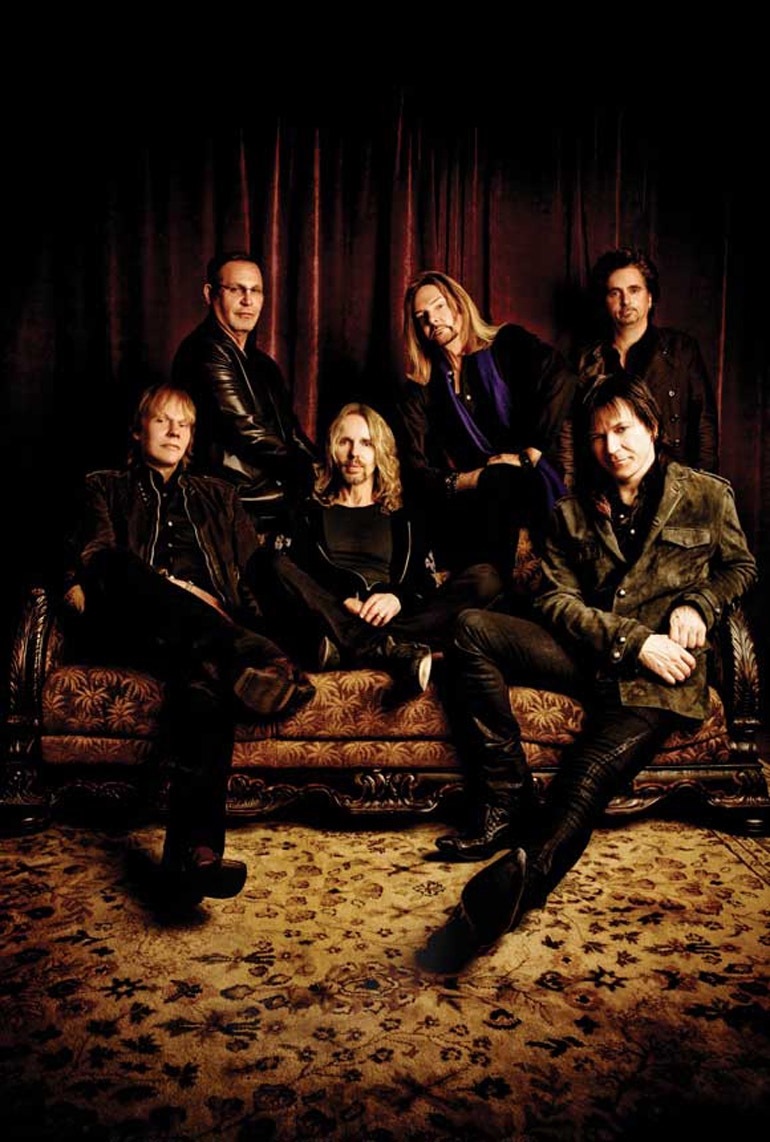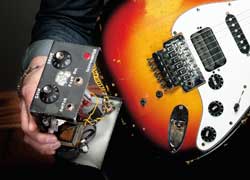
Members of the band Styx: [top, left to right] Chuck Panozzo, Ricky Phillips, Todd Sucherman
[bottom, left to right] James “J. Y.” Young (MAE ’70), Tommy Shaw, Lawrence Gowan
Photo: Art Newell
“Citizens of western DuPage County...” the guitarist purred into the microphone before erupting into the maniacal sentence-ending shout, “...LIGHT UP!” Many in the cheering crowd did just that, flicking open lighters and hoisting them high, in a tradition made popular at arena rock concerts of the ’70s and ’80s. Acknowledging the audience response, James Vincent “J. Y” Young (MAE ’70)—a lead guitarist and vocalist of the band Styx—smiled, sidled up next to his co-lead guitarist/vocalist, Tommy Shaw, and launched into “Light Up” from the band’s 1975 album Equinox. The scene seemed a mutual musical high shared by the boys in the band and their thousands of fans at this summer’s Naperville (Ill.) Exchange Club’s Ribfest 2013.
“Music communicates to everyone on a personal level and truly has the power to even heal” —James “J.Y.” Young
Playing a set list that included hits such as “Renegade,” “Come Sail Away,” and “Lady”—the song that propelled the Chicago-bred group into rock stardom—the present incarnation of the band performed before a crowd that spanned the generations from grandparent to grandchild. That Styx—now composed of Young, Shaw, Lawrence Gowan (vocals/keyboards), Ricky Phillips (bass guitar), Todd Sucherman (drums), and occasionally, original Styx bassist Chuck Panozzo—can appeal to such a wide range of ages both humbles and astounds Young, who joined the group the same year that he graduated from IIT.
“Music communicates to everyone on a personal level and truly has the power to even heal,” says Young in a phone conversation from Baton Rouge, La. He notes that band members have received mail over the years from fans who have written that certain Styx songs have helped to save someone’s life or have shepherded the writer through difficult times.
“I used to view my career choice as something that is completely egocentric and self-serving, and in some ways, it is,” says Young. “But when we get these letters, I recognize that we have a tremendous responsibility; I think we’ve done a reasonably good job of coping with that responsibility. And by going out and performing live concerts, we see that more and more young people under the age of 30 are becoming fans, too.”

A 20-something “J. Y.” in the early days of Styx
Photo: Georg Bosek
Young was, well, quite young when he began to play his first instrument, a piano. Music was a language commonly spoken in the Young household in Chicago’s Auburn/Highland neighborhood. Young’s parents started all of their children—Young, his two older sisters and two younger brothers (including Rick, who passed away in 2000)—on piano at age 5. Rather reluctantly, Young also took up the clarinet for several years, but weaned on the Beatles, at age 14 he became “enchanted” with his uncle’s new classical guitar. Young’s fingers took flight on the strings, as did his dream to become a professional rock musician.
While a student at the former Calumet High School, Young and his brother Rick, also an aspiring rock musician, formed the band The Catalinas and placed third in a regional contest, securing themselves a place in a “Talented Teen of America” tour of Canada and Europe. Young also discovered his aptitude for mathematics and science, and his father urged him to obtain a college degree. Knowing that his uncle Sheldon Young (CE ’44), an inventor, had graduated from IIT and founded the Vibro/Dynamics Corporation, a successful vibration isolation and shock control company, Young enrolled at the university while forming a new band, Monterey Hand, with his brother.

James “J. Y.” Young rocking the house at a 2010 concert.
Photo: Jason Powell
Soon after he graduated from IIT and in between his gig driving a taxi, Young successfully auditioned for the Chicago band TW4—composed of Dennis DeYoung (lead vocals/keyboards), John Curulewski (lead guitar), Chuck Panozzo (bass), and John Panozzo (drums). In 1972, the TW4 members changed their name to Styx. While Young admits that a career in the mechanical and aerospace engineering field was his “fallback position,” he says his degree paid off in more ways than he could have imagined.
“My education prepared me to solve real-world problems using math and science,” he explains, “and to be able to make judgments about advancements in technology as they came along, finding ways to apply them to what we did. A couple of times I was laughed at—I won’t mention by which of my colleagues in the band—when I suggested we get involved in digital recording, which would become a standard we would choose to use.”
Young says that besides his family connection to IIT, which includes his brother-in-law Kent Godsted (ME ’66), four classmates have had highly influential roles over the course of his life: James Morrin (MAE ’71, LAW ’76), who was Young’s personal attorney for many years; the late Dave Yoshinari (EE ’70), inventor of a custom-made guitar pedal; Paul Petraitis (DSGN ’71), who influenced Young’s musical tastes; and Steven A. Jones (DGSN ’71), movie producer and the creative mind behind all of the visual content used on Styx’s big-screen tours, including The Grand Illusion/Pieces of Eight tour and DVD.

The Yoshinarator was a sound device developed for “J. Y.” by Dave Yoshinari
(EE ’70).
Photo: Jim Tweedie
“Dave Yoshinari sat next to me in Engineering Orientation during my first semester,” recalls Young. “He invented a device—the Yoshinarator—that carried me through the height of Styx’s heyday as a recording act. That thing was amazing. We sat in his basement in Norridge, Ill., and he kept changing transistors with distortion, back in those days, and they all distorted differently. I was trying to play the start of Jimi Hendrix’s ‘Foxy Lady’ and we sat there until Dave found a transistor that worked.”
More than four decades have passed since Young shared a classroom with Yoshinari and lived in IIT’s Fowler Hall , “10 blocks north of the old Chess Studios at 2120 South Michigan, where blues artists and some of the Chuck Berrys of the world recorded,” he says. Styx has since gone global, playing concerts from Aruba to Japan, and scoring a number-one hit with “Boat on the River” in Austria, Germany, Israel, and Switzerland. The band averages 110 live shows each year and has sold some 30 million records worldwide. In the 1980s, Styx was nominated for a Grammy Award and had four consecutive multi-platinum albums as certified by the Recording Industry Association of America.
“I could write a book on what it was like watching from up close as my friend went from cab driver to superstar,” says IIT alumnus Jones, who was playing a bass guitar in the Farr Hall student lounge while in his first year at IIT, when alumnus Petraitis introduced him to Young. “I was excited and happy that ‘J. Y.’ had ‘made it,’ and I’d be lying if I didn’t admit, as a musician myself, to a bit of envy. In hindsight, no one deserves success more than James V. Young.”
Editor’s Note: An IIT Magazine online exclusive profile of Steven A. Jones (DSGN ’71) can be found at magazine.iit.edu/category/online-exclusives
More Online
StyxWorld: www.styxworld.com
Making of Styx: The Grand Illusion/Pieces Of Eight Live DVD http://youtube.com/watch?v=8NPwS0u90Ug